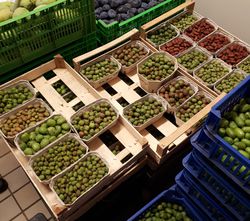 Who doesn't know the kiwi fruit from the supermarket? With its green or even yellow flesh and brown, slightly hairy skin, with its typical sour-sweet taste and exotic aroma?
Who doesn't know the kiwi fruit from the supermarket? With its green or even yellow flesh and brown, slightly hairy skin, with its typical sour-sweet taste and exotic aroma?
But who knows the small-fruited relative of the kiwi fruit, the mini kiwi? Nurserymen and hobby gardeners, but also people interested in fruit will have heard of the mini kiwi, sometimes also called kiwi berry. But in the grocery store you will usually look in vain for them. If at all, the mini kiwi is only to be found in some fruits displays during a short phase in autumn. Read on to find out everything you need to know about this special berry fruit.
Mini kiwis in the genus Actinidia
The plant genus Actinidia comprises about 55 species. The natural distribution area of these woody and mostly dioecious plants is mainly in East Asia, where the different species can be found from cold Siberia to subtropical China.
Botanical classification
All species are grouped into four sections (Maculatae, Leiocarpae, Stellatae and Strigosae). The first two sections (Maculatae and Leiocarpae) are certainly the most interesting for us. This is because the species assigned to them are most adapted to low winter temperatures. For example, the species or subspecies of the yellow and green kiwi fruit (Actinidia chinensis/chinesis var. deliciosa) is included in the section Maculatae. However, the species of the section Leiocarpae are the most resistant in terms of frost hardiness. These include the mini kiwi species of kiwi berry (Actinidia arguta) and the variegated-leaf hardy kiwi (Actinidia kolomikta).
Depending on the species, the frost hardiness of the mini kiwifruit can be between -25°C (Actinidia arguta) and -35°C (Actinidia kolomikta). However, these values refer to absolute winter dormancy. As soon as the buds begin to sprout in the spring, the freshly developing leaves and shoots are extremely susceptible to late frosts. The plants usually survive such an event and sprout again after a while. However, this can lead to a total crop failure, as the already formed flower buds also freeze.
The growth of a mini kiwi
All kiwi species, including the mini kiwi, are climbing plants in the horticultural sense. The correct botanical name here would actually be liana (I would love to know how many readers thought of Tarzan when they read this word). Lianas are plants whose roots grow in the ground and whose mostly woody shoots grow upwards on trees or other vertical objects. Thus, the use or training of mini kiwi plants in the garden is also obvious. Mini kiwi plants always need a trellis or climbing framework on which they can spread.
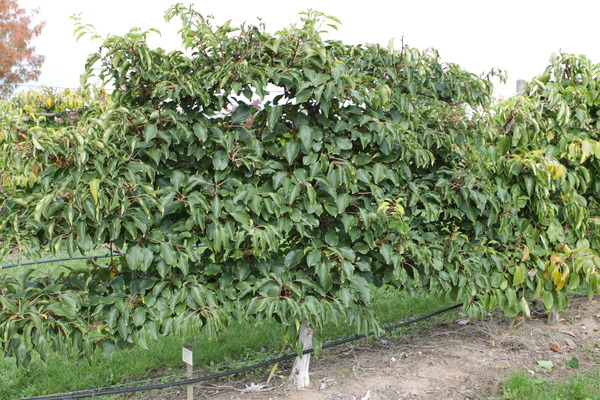
Picture: This is how a mini kiwi plant can also look, strongly cut into shape...
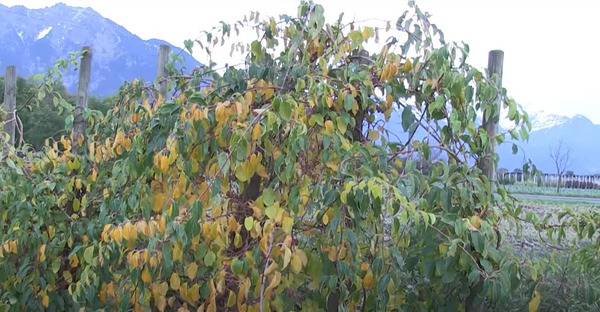
...or so, mostly free-growing without significant pruning measures
The fruits of a mini kiwi
The fruits of the mini kiwi give rise to the names mini kiwi and kiwi berry. In transverse and longitudinal section, the close relationship to the large kiwi fruit can be clearly seen. The arrangement of the seeds around the central axis of the fruit is very typically pronounced. The real difference to the large relative is the fruit size and the fruit skin. The average weight of a classic, large kiwi fruit is more than 70 g, whereas the maximum weight of the mini kiwi is currently around 12 - 15 g. In addition to the fruit size, the fruit skin is also a main point of differentiation. In contrast to the large kiwi fruit with its brownish and slightly hairy fruit skin, the mini kiwi has a smooth and completely hairless fruit skin. This has the advantage that a mini kiwi fruit can be eaten whole without having to peel it first. The colour of the skin of a mini kiwi varies, depending on the variety, from a fresh light green to dark green with slightly red 'cheeks' to a bright red.
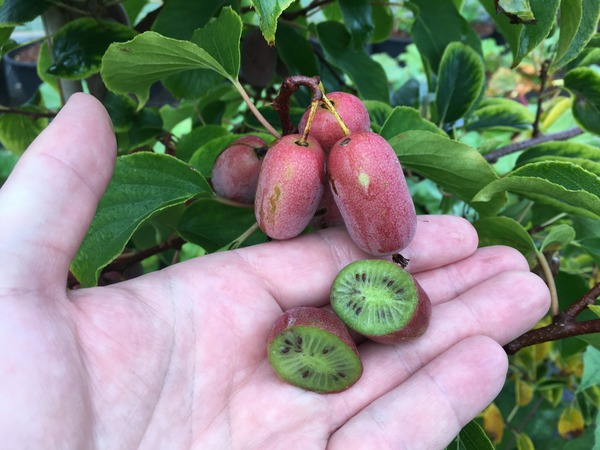
Picture: The cross-section shows the close relationship to the fruit of the fuzzy kiwi - here the variety 'Pink Jumbo'.
The most important mini kiwi species
In the genus Actinidia there are some species with pronounced winter hardiness and smooth-skinned fruits. However, not all of these species are of economic importance since the fruits of these species are not suitable for consumption. The fruits stand out because of their special colouring; for example Actinidia macrosperma has round and bright orange fruits, but these fruits are inedible because of their bitter and pungent taste. Although they are not poisonous, they are anything but a culinary revelation.

Picture: the not yet fully ripened fruit of Actinidia macrosperma - it looks beautiful but is unfortunately inedible.
The mini kiwi species that have produced the best tasting varieties so far and also have the greatest economic importance in horticulture are described in more detail below.
Actinidia kolomikta – the variegated-leaf hardy kiwi
The variegated-leaf hardy kiwi, sometimes also called kolomikta or miyamatatabi, is one of the most frost hardy Actinidia species of all. When it is completely dormant, the species can survive temperatures down to-35°C unharmed. In direct comparison to the kiwi berry, the growth of the variegated-leaf hardy kiwi is somewhat weaker and the plants reach a height of up to 4 m if left to grow undisturbed.
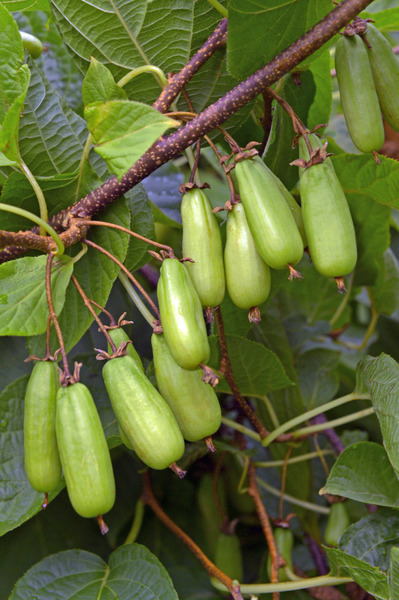
Picture: Fruits of the summer kiwi on the plant - the typical brown rind with the conspicuous lenticels can be seen clearly.
However, the pronounced winter hardiness and reduced growth is at the expense of the fruit size. Kolomikta varieties have the smallest fruits of all mini kiwi species. Generally, the light green fruits weigh only about 5 g. However, the fruits are extremely rich in vitamin C with an average of almost 1,000 mg/100ml. In individual studies, vitamin C contents of up to 3,000 mg/100ml have been found. From the budding stage up to the ripe fruit, Actinidia kolomikta needs about 130 frost-free days.
In the summer, some varieties are characterised by their variegated foliage (white/pink leaf tips), hence the name variegated-leaf kiwi.
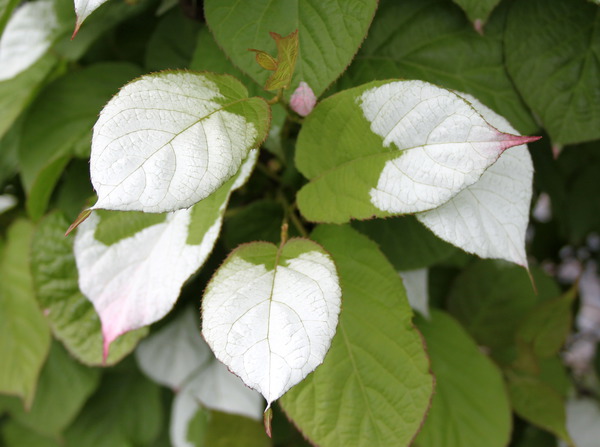
Picture: the partially coloured leaves of the summer kiwi are very striking
Through crossings with this mini kiwi species, attempts are being made to transfer the pronounced winter hardiness and the high vitamin C values to other kiwi species.
Actinidia arguta – the kiwi berry
The kiwi berry is the real flagship of the mini kiwis. Depending on the country or region, the kiwi berry is also sometimes called hardy kiwi, kokuwa or tara vine.
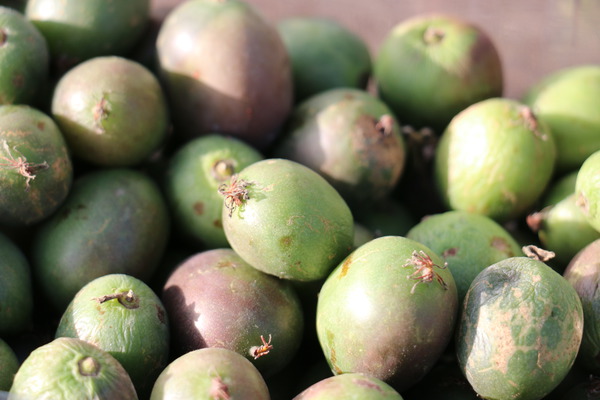
Picture: typical fruits of the kiwi berry
The kiwi berry is a strong-growing climbing plant and can reach a height of up to 15 m in Central Europe, if left to grow. In its original habitat in East Asia, the kiwi berry can also grow up to 25 m tall. This perennial vine can withstand winter frosts from -25°C to -30°C without any problems. With some varieties this can be a little more or a little less.
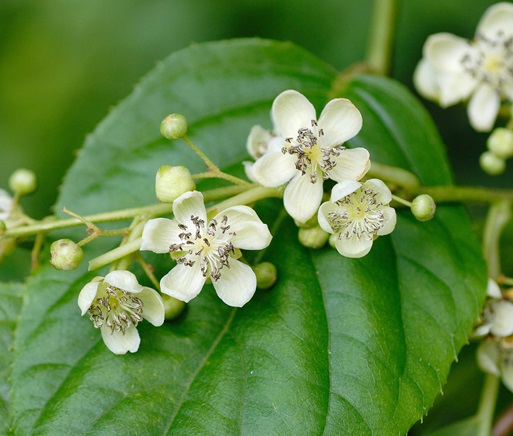
Picture: When in blossom, the kiwi berry plants spread a sweet honey scent.
The attractive thing about kiwi berries is, on the one hand, the numerous and sweet-smelling flowers, which are very popular with insects, and on the other hand the delicious, sweet fruits. Depending on the variety, the colour of the fruit can be quite different. Here the colour spectrum ranges from an intense light green to dark green with red 'cheeks' to a bright red. Like the colour, the taste can be sometimes sweeter and sometimes a little more acidic, depending on the variety. The kiwi berry needs about 150 frost-free days to ripen. The fruits can then weigh up to 15 g.
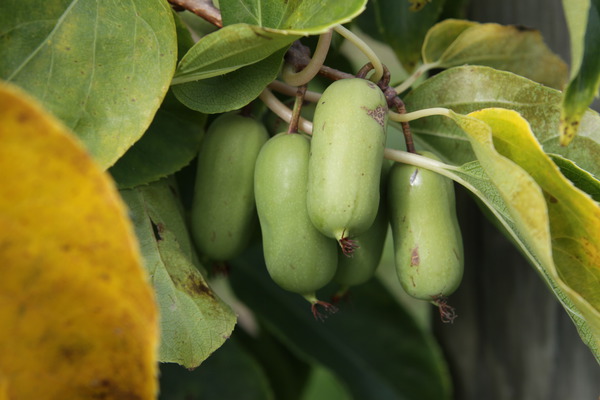
Picture: Kiwi berry 'Super Jumbo' - currently the variety with the largest/heaviest fruits
Besides the sweet taste, the fruits are also rich in vitamins (though rather poor for Actinidia) and minerals.
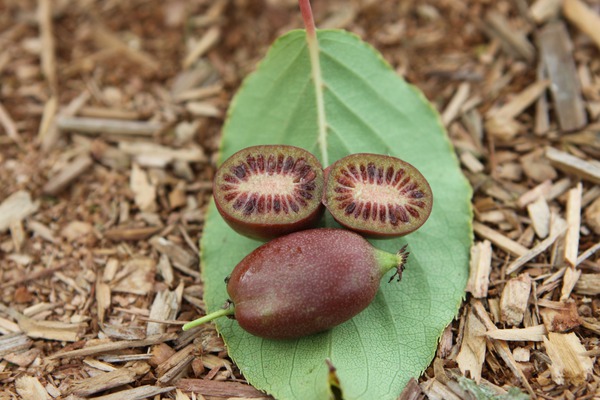
Picture: There are also varieties with a red flesh - here the kiwi berry 'Red Jumbo'.
Here is an overview of the average vitamin and mineral content of Actinidia arguta compared to Actinidia kolomikta:
| Vitamin/Mineral | Actinidia arguta | Actinidia kolomikta |
| Vitamin C | 80 mg% | 930 mg% |
| Vitamin P | 55 mg% | 26 mg% |
| Carotene | 0.28 mg% | 0.26 mg% |
| Acidity | 1.29 mg% | 1.26 mg% |
| Sugar content | 8.4% | 5.7% |
Other species
To all those who might find fault with the fact that the two, red-fleshed species Actinidia purpurea and Actinidia melanandra are not listed here, I would like to clarify in advance that this was done on purpose. Since the species 'purpurea' is, according to the latest scientific statements, a variety of the kiwi berry (Actinidia arguta), a separate listing is not necessary. The species 'melanandra' is a species in its own right, but is usually used almost exclusively as a crossing partner for red-fleshed genetics. Beyond that, this species has no further horticultural significance.
Mini kiwis – tasty and extremely healthy
Mini kiwis produce attractive and extremely tasty little fruits, but as you can see from the table above, mini kiwis have much more to offer besides their taste. The small fruits also convince with the quantity and content of their health-promoting ingredients. For example, kiwi berries have a higher content of vitamin C than lemons.
In addition to the exceptionally high vitamin C content, mini kiwis also contain a variety of other vitamins. Besides the vitamins, mini kiwis have high levels of antioxidants and various minerals such as potassium, calcium, magnesium, phosphorus and sodium.
Furthermore, mini kiwis have the highest content of lutein than any other fruit. Among other things, lutein is used in food supplements for eye health. Studies have also shown that lutein can help reduce the risk of cataracts.
The advantages of mini kiwis
We have already written about the health benefits of the mini kiwi. Now we would like to show you what horticultural and gardening advantages a mini kiwi plant has for the garden and the gardener.
- The mini kiwi plants are more frost hardy than, for example, the large-fruited kiwis
- There are more regular yields due to the higher frost hardiness
- They offer an earlier ripening time – mini kiwis ripen already from the middle/end of September; large-fruited kiwis usually have to be harvested unripe before the first frost in Central Europe in order to let them ripen afterwards
- They are small and smooth-skinned fruits that can be eaten with the skin directly from the plant
- There are lots of intensely fragrant flowers
More kiwi articles
Please also read our mini kiwi assortment article about the different varieties we have on offer.
